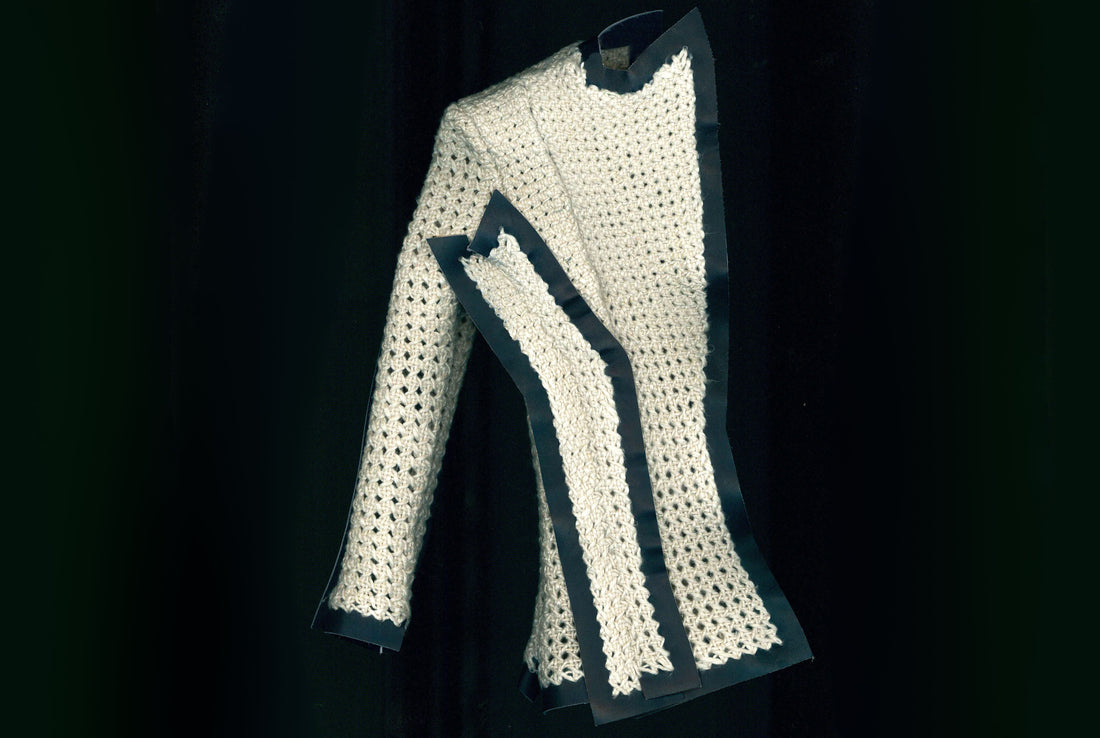
15% LESS: UROOS JAMAL
Growing up in India, my fascination with traditional crafts and its potential to empower communities has acted as a driving force behind my work. Guided by a deep interest in sustainable lifestyles, I've ventured into various dimensions of sustainable fashion, exploring alternative materials, production techniques, and design approaches. At present my aim is to reduce the extra 15-20% of fabric that is wasted while creating a piece of clothing, using the conventional ways of pattern cutting. Although zero waste pattern cutting addresses this to some extent, applying it to create fitted tailored pieces poses many more challenges. In addition, the recycling and biodegradability of multi-textile-layered garments present ongoing concerns within the industry.
To address these challenges, I design fabrics in the shape of pattern pieces for items of clothing. This is made possible through multiple techniques, but currently my focus lies in weave and crochet techniques and through these I am able to maintain the density and stability of textiles.

Image: 325 Hours Jacket by Uroos Jamal. Photo courtesy of Abhay Khatri. Image above: jacket by Uroos Jamal.
When it comes to the biodegradable and recyclable aspect of the garments, I predominantly employ yarn, spun from pre-consumer silk waste, sourced from Bhagalpur, a district known for its ancient silk production. Repurposing aids sustainable production methods, supports local small-scale industries, and mitigates environmental impact.
At the same time, whilst working in the industry, I've been closely examining its demographics and wage disparities, particularly affecting women who constitute more than 70% of the workforce. Despite this, the women face unequal pay, physical and sexual abuse and withholding of wages.
I firmly believe that a woman’s financial independence can not only enhance her well-being but also contribute to the betterment of her family and the community at large. Having observed the societal constraints that restrict women's work beyond their households, I chose to utilise low-tech tools. A needle, a universally available and easily portable instrument, became my primary tool to create fabrics. By altering the stitches and later teaching the women at their own pace, they became fluent and worked from the comfort of their homes to bring the garment to the comfort of the consumer.

Image: 1076 Hours Jacket by Uroos Jamal.
During my time at Royal College of Art, I created a versatile metal frame that allows multiple pattern pieces to be woven, using a single base. This innovation offers a lighter, more portable alternative to traditional looms, taking up less space. Notably, this approach minimises waste since the fabric does not need to be cut into specific pattern pieces for each garment. My objective is to establish replicable sustainable models in various communities, empowering more individuals to break free from socio-economic constraints and lead fulfilling lives.
The garments, however, are the by-products. My accomplishment lies in empowering women to attain social and economic independence. Addressing challenges like domestic violence, basic necessities, education and upskilling forms the core of my work.
My intention is to further collaborate with these skilled women by refining the crochet techniques, making it durable and introducing novel patterns.

Image: 422 hours jacket by Uroos Jamal. Photo courtesy of Niharika Kumar.
Text by Uroos Jamal
Find out more and follow Uroos Jamal:
@uroosjamal
To address these challenges, I design fabrics in the shape of pattern pieces for items of clothing. This is made possible through multiple techniques, but currently my focus lies in weave and crochet techniques and through these I am able to maintain the density and stability of textiles.

Image: 325 Hours Jacket by Uroos Jamal. Photo courtesy of Abhay Khatri. Image above: jacket by Uroos Jamal.
When it comes to the biodegradable and recyclable aspect of the garments, I predominantly employ yarn, spun from pre-consumer silk waste, sourced from Bhagalpur, a district known for its ancient silk production. Repurposing aids sustainable production methods, supports local small-scale industries, and mitigates environmental impact.
At the same time, whilst working in the industry, I've been closely examining its demographics and wage disparities, particularly affecting women who constitute more than 70% of the workforce. Despite this, the women face unequal pay, physical and sexual abuse and withholding of wages.
I firmly believe that a woman’s financial independence can not only enhance her well-being but also contribute to the betterment of her family and the community at large. Having observed the societal constraints that restrict women's work beyond their households, I chose to utilise low-tech tools. A needle, a universally available and easily portable instrument, became my primary tool to create fabrics. By altering the stitches and later teaching the women at their own pace, they became fluent and worked from the comfort of their homes to bring the garment to the comfort of the consumer.

Image: 1076 Hours Jacket by Uroos Jamal.
During my time at Royal College of Art, I created a versatile metal frame that allows multiple pattern pieces to be woven, using a single base. This innovation offers a lighter, more portable alternative to traditional looms, taking up less space. Notably, this approach minimises waste since the fabric does not need to be cut into specific pattern pieces for each garment. My objective is to establish replicable sustainable models in various communities, empowering more individuals to break free from socio-economic constraints and lead fulfilling lives.
The garments, however, are the by-products. My accomplishment lies in empowering women to attain social and economic independence. Addressing challenges like domestic violence, basic necessities, education and upskilling forms the core of my work.
My intention is to further collaborate with these skilled women by refining the crochet techniques, making it durable and introducing novel patterns.

Image: 422 hours jacket by Uroos Jamal. Photo courtesy of Niharika Kumar.
Text by Uroos Jamal
Find out more and follow Uroos Jamal:
@uroosjamal

1 comment
I found his process of weaving the actual pattern pieces fascinating. It would be even more so to actually be able to see from start to finish.